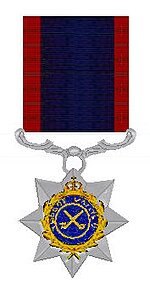Indian Order of Merit
| Indian Order of Merit | |
|---|---|
 Indian Order of Merit (2nd Class, Military Division) (top)
Ribbon (bottom) |
|
| Awarded by British Empire |
|
| Type | Military decoration |
| Eligibility | Indian citizens in the armed forces and civilians (civilian division) |
| Awarded for | Gallantry |
| Status | Discontinued in 1947 |
| Post-nominals | IOM |
| Statistics | |
| Established | 1837 |
| Precedence | |
| Next (higher) | Victoria Cross |
The Indian Order of Merit (IOM) was a military and civilian decoration of British India. It was established in 1837, (General Order of the Governor-General of India, No. 94 of 1 May 1837) although following the Partition of India in 1947 it was decided to discontinue the award and in 1954 a separate Indian honours system was developed, to act retrospectively to 1947. For a long period of time the IOM was the highest decoration that a native member of the British Indian Army could receive and initially it had three divisions. This was changed in 1911 when Indian servicemen became eligible for the Victoria Cross. A civilian division of the IOM also existed between 1902 and 1939, however, it was only conferred very rarely.
The medal was first introduced by the East India Company in 1837, under the name "Order of Merit" and was taken over by the Crown in 1858, following the Indian Mutiny of 1857. The name of the medal was changed in 1902 to avoid confusion with a British Order of the same name. The Indian Order of Merit was the only gallantry medal available to Native soldiers between 1837 and 1907 when the Indian Distinguished Service Medal was introduced, and when the Victoria Cross was opened to native soldiers in 1911. Both divisions of the order were removed when India became independent in 1947. Recipients receive the post nominal letters IOM.
The original object was to "afford personal reward for personal bravery without reference to any claims founded on mere length of service and general good conduct"
The medal was originally introduced with three classes (first, second and third classes), until others medals were made available to Indian soldiers, at which point it was reduced to two classes (the Victoria Cross replacing the first class), and reduced to one class in 1944. A recipient technically needed to be in possession of the lower class before being awarded a higher class, although recipients were sometimes awarded the higher class if they performed more than one act of gallantry, then they may have been awarded the higher class, without receiving the lower one. The recipients of the order received increased pay and pension allowances and were very highly regarded.
...
Wikipedia
